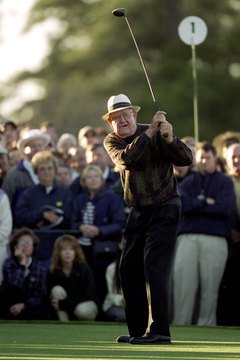Golf writer Harry Hurt III notes that “the search for the perfect (golf) swing has been going on since the royal and ancient game began.” While he agrees with conventional wisdom that there’s no such thing as the perfect swing, he also believes “you can still find a swing that is ‘perfect’ for you and your own golfing goals.” There are many ways to swing a golf club, but a solid golf swing begins with the correct grip, aim and stance, according to PGA professional Michael Samaniego.
Step 1
Take a “relaxed fundamental grip,” Samaniego advises. In a classic overlapping grip, the left hand (for a right-handed player) grasps the end of the club, with the thumb pointing down the shaft and the V shape formed by the thumb and forefinger pointed toward your chin, according to golf writer Steve Newell. Place your right hand below the left, with the right pinkie resting between the first and middle fingers of your left hand. The V shape formed by the thumb and forefinger of your right hand should point toward your right shoulder.
Step 2
Visualize the shot you want to hit, recommends golf instructor Shawn Clement. As you set up, don’t just look down at the ball -- lift your head to “recall the picture” you visualized prior to setup, and make sure the picture matches the setup.
Step 3
Aim your club face toward the target as you address the ball. Newell suggests taking aim at an object or spot much closer than your intended target, “on a line directly between the ball and the target.”
Step 4
Set up so imaginary lines drawn between your feet, knees, hips and shoulders will all be parallel to a line drawn from the ball to your target. Your stance will change depending on the club you’re using, but in general you’ll keep your feet shoulder-width apart and your knees flexed. Bend forward from the waist. Newell suggests setting up with about one hand-width between the top of your club and your thigh.
Step 5
Keep your body centered as you bring the club back and begin your downswing, says PGA Tour pro Sean O’Hair. O’Hair advises imagining a shaft planted in the ground just to the right of your right hip. “I want my right hip to turn, but move away from the shaft” as opposed to bumping into the shaft, O’Hair says. After reaching the top of your swing, rotate your body back toward its original position, with no lateral, swaying movement. Keep your head down at impact. “You need to watch the club make contact with the ball,” says Samaniego.
Step 6
Keep your left arm straight through the backswing, the late Hall of Fame golfer Ben Hogan advised. On the follow through, however, the right arm should straighten and “most important, the body follows the swing,” Hogan said.

